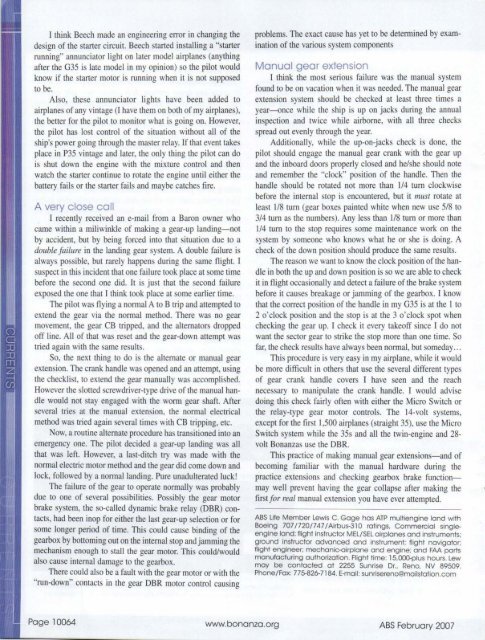February 2007 - American Bonanza Society
February 2007 - American Bonanza Society
February 2007 - American Bonanza Society
Create successful ePaper yourself
Turn your PDF publications into a flip-book with our unique Google optimized e-Paper software.
I think Beech made an engineering enor in changing thedesign of the starter circuit. Beech staned installing a "stanerrunning" annunciator light on later model airplanes (anythi ngafter the G35 is late model in my opinion) so the pilot wouldknow if the staner mOlOr is running when it is not supposedto be.Al so, these annunciator lights have been added toairplanes of any vintage (l have them on both of my airplanes),the better for the pilot to monitor what is going on. However,the pilot has lost control of the situation without all of theship's power going through the master relay. If that event takesplace in P35 vintage and later, the only thing the pilot can dois shut down the engine with the mixture control and thenwatch the staner continue to rotate the engine until either thebattery fail s or the staner fails and maybe catches fire.A very close callI recently received an e-mail from a Baron owner whocame within a miliwinkle of making a gear-up landing- notby accident, but by being forced into that situation due to adouble failure in the landing gear system. A double failure isalways possible, but rarely happens during the same flight. Isuspect in this incident that one failure took place at some timebefore the second one did. It is just that the second failureexposed the one that lthink lOok place at some earlier time.The pilot was flying a normal A to B trip and attempted toextend the gear via the normal method. There was no gearmovement, the gear CB tripped, and the alternators droppedoff line. All of that was reset and the gear-down attempt wastried again with the same results.So, the next thing to do is the alternate or manual gearextension. The crank handle was opened and an attempt, usingthe checklist, to extend the gear manually was accomplished.However the slotted screwdriver-type drive of the manual handlewould not stay engaged with the worm gear shaft. Afterseveral tries at the manual extension, the normal electricalmethod was tried again several times with CB tripping, etc.Now, a routine alternate procedure has transitioned into anemergency one. The pilot decided a gear-up landing was allthat was left. However, a last-ditch try was made with thenormal electric motor method and the gear did come down andlock, followed by a normal landing. Pure unadulterated luck!The failure of the gear to operate normally was probablydue to one of several possibilities. Possibly the gear motorbrake system, the so-called dynamic brake relay (DBR) contacts,had been inop for either the last gear-up selection or forsome longer period of time. This could cause binding of thegearbox by bottoming out on the internal stop and jamming themechanism enough to stall the gear motor. This could/wouldalso cause internal damage to the gearbox.There cou ld also be a fau lt with the gear motor or with the"run-down" contacts in the gear DBR motor control causingproblems. The exact cause has yet lO be determined by examinationof the various system componentsManual gear extensionI think the most serious failure was the manual systemfound to be on vacation when it was needed. The manual gearextension system should be checked at least three times ayear-once while the ship is up on jacks during the annualinspection and twice while airborne, with all three checksspread out evenly through the year.Additionally, while the up-an-jacks check is done, thepilot should engage the manual gear crank with the gear upand the inboard doors properly closed and helshe should noteand remember the "clock" position of the handle. Then thehandle should be rotated not more than 114 turn clockwisebefore the internal SlOp is encountered, but it musf rotate atleast 1/8 turn (gear boxes painted white when new use 5/8 lO3/4 turn as the numbers). Any less than 1/8 turn or more than1/4 turn to the stop requires some maintenance work on thesystem by someone who knows what he or she is doing. Acheck of the down position should produce the same results.The reason we want to know the clock position of the handlein both the up and down position is so we are able to checkit in flight occasionally and detect a fai lure of the brake systembefore it causes breakage or jamming of the gearbox. l knowthat the correct position of the handle in my G35 is at the I to2 o'clock position and the stop is at the 3 o'clock spot whenchecking the gear up. I check it every takeoff since I do notwant the sector gear to strike the stop more than one time. Sofar, the check results have always been normal, but someday ...This procedure is very easy in my airplane, while it wouldbe more difficult in others that use the several different typesof gear crank handle covers I have seen and the reachnecessary to manipulate the cra nk handle. I would advisedoing this check fairly often with either the Micro Switch orthe relay-type gear motor controls. The 14-volt systems,except for the first 1,500 airplanes (straight 35), use the MicroSwitch system while the 35s and all the twin-engine and 28-volt <strong>Bonanza</strong>s use the DBR.This practice of making manual gear extensions-and ofbecoming familiar with the manual hardware during thepractice extensions and checking gearbox brake functionmaywell prevent having the gear collapse after making thefirst for real manual extension you have ever attempted.ASS life Member Lewis C. Gage has AlP multiengine land withBoeing 707/720/747 /Airbus-310 ratings. Commercial singleengineland: flight instructor MEl/SEL airplanes and instruments:ground instructor advanced and instrument: ftight navigator:night engineer; mechanic-airplane and engine; and FAA partsmanufacturing authorization. Flight time: 15,00o-plus hours. Lewmay be contacted at 2255 Sunrise Dr., Reno, NV 89509.Phone/Fax: 775-82&7184. E-mail: sunrisereno@mailstation.comPage 10064 www.bonanza.org ABS <strong>February</strong> <strong>2007</strong>

















